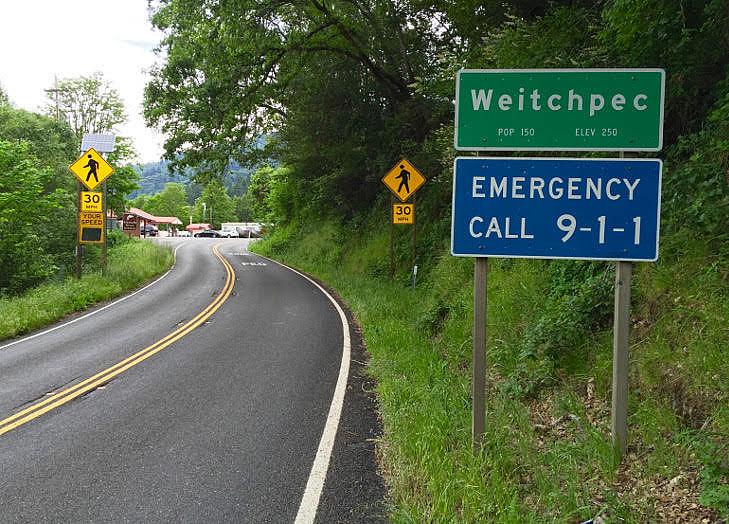To understand youth suicides on remote reservation, immersive reporting proves crucial

The only paved road into and out of the remote rural community of Weitchpec in Humboldt County, Calif. (Photo by Ryan Burns)
In late December 2015, the Yurok Tribe, California’s largest indigenous group with more than 6,000 members, declared a state of emergency in response to a series of seven suicides over the preceding year and a half. All seven of these suicides were committed by young people, ranging in age from 16 to 32, and they all lived in a tiny, extremely remote community called Weitchpec.
Shortly after the emergency declaration, the tribe issued a lengthy press release in response to the crisis and outlining the initial stages of its plan to address the underlying issues. While this official statement provided a wealth of information, I felt that if the larger community hoped to truly understand the dimensions of this crisis, it was essential to take a closer look at the isolated rural community where it was happening.
“Residents there have almost no cell or internet coverage,” the press release noted. “Many family homes do not yet have electricity. Getting groceries requires an hour-long drive and transportation is difficult due to the fact that there is only one paved road.”
This lifestyle, coupled with the extreme poverty and substance abuse prevalent on the reservation, sounded so foreign to the everyday experiences of most locals — even here in rural Humboldt County — that I thought it imperative to spend time in Weitchpec in order to see the day-to-day experiences of its residents through their own eyes.
On my first trip there in June, I sat in on a community meeting held on the lawn outside the Weitchpec Community Center. Perched above the confluence of the Trinity and Klamath rivers, the meeting site provided a casual setting that included a gas grill where a tribe member was cooking burgers for the group.
By sitting in on this meeting, which had been organized primarily to address the suicide crisis, I was able to hear locals engaged in casual banter as well as serious discussion. For example, in discussing possible incentives for community members to receive training in suicide prevention, attendees playfully joked about the challenges of such remote living, from the lack of internet service for many to one family who kept a cell phone hanging from a string outside their house because that was the only spot on the property to get service.
I had heard from a variety of people both inside and outside the tribe that this “upriver community,” as the folks around Weitchpec are known, is particularly insular and suspicious of outsiders. I didn’t find that to be true for the duration of that first visit, but upon my return I learned just how rare an opportunity I’d been afforded.
In the weeks and months that followed I made repeated attempts to organize a follow-up visit. I was relying — too heavily, I realized in retrospect — on the tribe’s official spokesman to act as an intermediary, someone to facilitate another event where I could hear from tribe members in their own environment. My idea for a follow-up story was to connect with the young members of the tribe, the segment of the community at increased risk of suicide.
According to the Centers for Disease Control, the suicide rate among American Indian and Alaska Native adolescents and young adults (those aged 15 to 34) is 50 percent higher than in the population at large. Among American Indians and Alaska Natives aged 10 to 34, suicide is the second leading cause of death. Furthermore, there’s a growing body of scientific evidence suggesting that suicide can be contagious, especially among young people.
So I felt it was essential to meet some young members of the tribe. But I had failed during my first visit to establish more points of contact with community leaders. Repeated phone calls and emails to the tribal spokesman yielded numerous promises, excuses (all quite legitimate) and apologies, but no apparent progress.
Eventually, however, the spokesman put me in touch with an educator who told me via email that she hoped to organize a “Youth Wellness Day” event. In November I traveled to an even more remote community center, almost two hours from the county seat of Eureka to attend this event, which brought together a group of Yurok students from sixth through 12th grades.
Kids spoke about such challenging topics as colonization, daily stressors, depression, substance abuse and behavioral counseling, in a way that they’d never communicate directly with an outsider such as myself.
Early in the process of researching this story, I had considered trying to organize a series of interviews with tribal leaders and the community members most directly involved in the suicide prevention measures. And I did so over the course of this California Fellowship project. But ultimately I gathered more useful information by observing members of this insular and isolated community interact with one another.
It’s been almost exactly a year since the tribe declared a state of emergency, and remarkably there have been no youth suicides among the Yurok during that time. My experiences interacting with and observing segments of the tribal community in their own, unique cultural environment has given me an illuminating glimpse into their daily lives. I hope to draw on those experiences as I continue to report on tribal issues.
Read Ryan Burns’ fellowship stories here.

